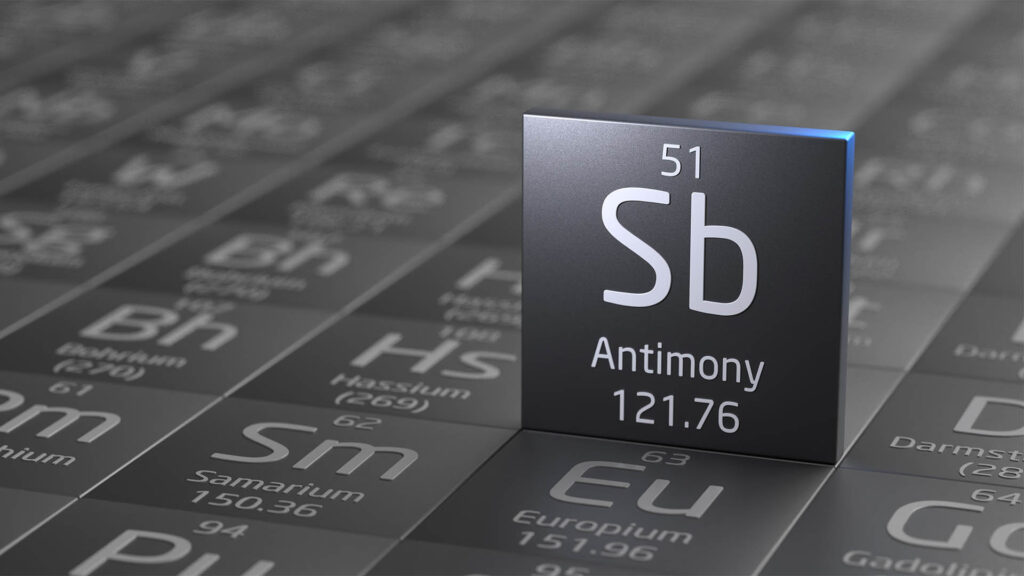The ongoing great power competition between the United States and China has increasingly focused on technological supremacy. This extends beyond cutting-edge technologies like advanced AI, high-end chip manufacturing, and quantum computing, to include the critical supply chains that support them—especially minerals crucial for modern industries.
As the global shift towards clean energy accelerates, minerals such as cobalt, lithium, and rare earth elements have garnered significant attention in business, international relations, and sustainability circles. Yet, amidst the scramble for these resources, another critical metal—antimony—has quietly emerged as a highly contested commodity. Following China’s recent announcement of export restrictions on antimony, concerns over supply chain vulnerabilities have grown, intensifying competition among the world’s leading powers.
Antimony, a rare and unevenly distributed metalloid, plays a crucial role in producing high-tech and defense materials, including flame retardants, semiconductors, and superhard materials. China dominates the global antimony supply chain, holding 32% of the world’s known deposits and producing more than 48% of global output.
China’s decision to limit antimony exports, effective September 15, 2024, is aimed at safeguarding “national security and interests.” While the restrictions are not explicitly aimed at any specific country, the geopolitical implications are profound. China has been gradually reducing its antimony output, which has driven up global prices and raised concerns about the stability of supply chains, particularly for the United States, which relies on China for 63% of its antimony imports.
This move appears to align with China’s broader strategy of resource nationalism—protecting strategic materials while limiting rivals’ access to them. By controlling the global supply of antimony, China reinforces its dominance in the market, gaining leverage in international trade.
The global scramble for antimony is the latest example of how technological competition is shaping geopolitical relations. Antimony is one of several elements classified as “critical” by major powers like the U.S., China, Australia, Russia, and the European Union. China’s restrictions on antimony follow similar curbs on germanium, gallium, graphite, and rare earths, demonstrating its strategy to leverage its control over key materials in response to U.S. efforts to restrict Chinese access to advanced technologies, such as high-end semiconductors.
Markets have responded swiftly to China’s antimony announcement. In Australia, Larvotto Resources—an exploration company focused on high-demand commodities, including antimony—saw a sharp rise in its stock price, driven by expectations that Australia could help fill the market gap left by China. The country’s Hillgrove Gold-Antimony Project, one of the world’s largest, is seen as a potential alternative source of supply. Australia, already a key U.S. partner in critical mineral supply chains, may play an increasingly vital role as these geopolitical tensions escalate.
However, China’s restrictions specifically target high-purity antimony compounds, which require advanced processing technologies. This means that while Australia might increase production of lower-grade antimony, its ability to replace China’s high-value-added products remains limited. With 86% of Australia’s antimony exports currently processed in China, Australia’s strategic value in this supply chain remains dependent on Chinese processing infrastructure. Investing in advanced processing capabilities is risky, especially if China lifts restrictions and retakes the market with cheaper, more efficient production.
For Australian policymakers, the challenge will be to navigate these complexities while maintaining an independent stance amid growing competition between global powers. As the rivalry for control over critical resources like antimony intensifies, the stakes for technological and geopolitical dominance continue to rise.
At its core, the scramble over antimony is a reflection of the broader struggle for technological supremacy between the U.S. and China. Both countries are vying to secure critical resources, define future technological systems, and outpace each other in innovation. However, this pursuit of dominance comes with significant risks—fragmented supply chains, increased resource nationalism, and more trade restrictions. As competition overshadows cooperation, the race for technological progress risks becoming a zero-sum game.
Within the Australian landscape, some big news today came from Trigg Minerals (ASX:TMG), which has launched a maiden exploration program at its ultra-high-grade Taylors Arm Project (EL 9668) in northern New South Wales, which is considered highly prospective for antimony and gold mineralisation. The project encompasses 71 historical workings, including significant sites like the Swallows Nest Mine and Testers Mine, which have reported exceptionally high grades of antimony. With rising antimony prices following China’s recent export bans, Trigg aims to unlock further economic value through modern exploration techniques while minimising environmental and community impacts.

